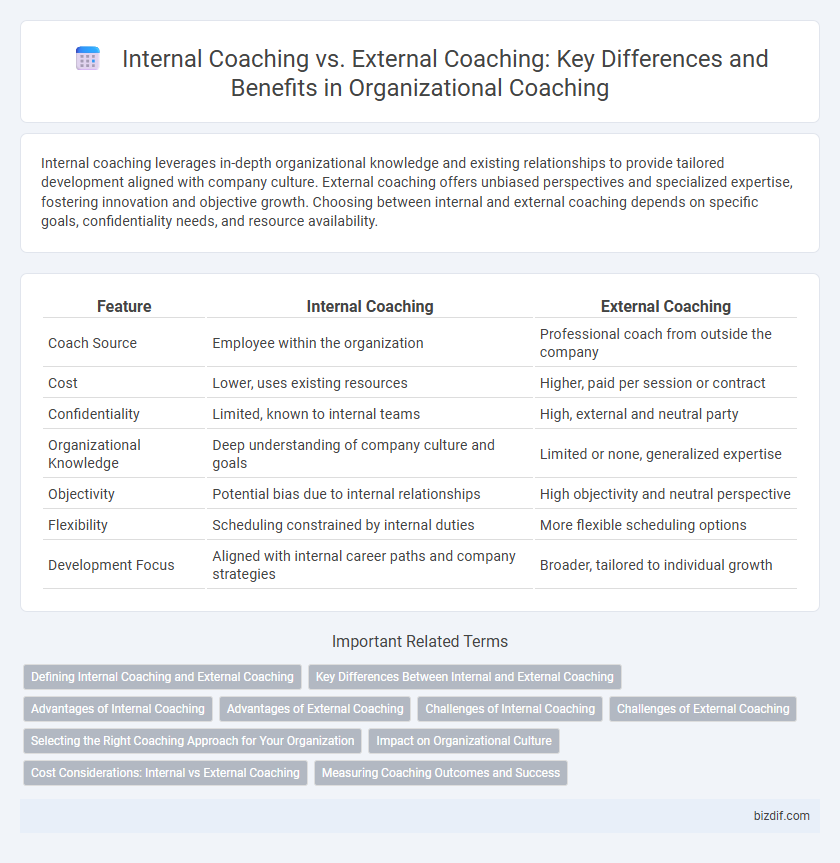Internal coaching leverages in-depth organizational knowledge and existing relationships to provide tailored development aligned with company culture. External coaching offers unbiased perspectives and specialized expertise, fostering innovation and objective growth. Choosing between internal and external coaching depends on specific goals, confidentiality needs, and resource availability.
Table of Comparison
| Feature | Internal Coaching | External Coaching |
|---|---|---|
| Coach Source | Employee within the organization | Professional coach from outside the company |
| Cost | Lower, uses existing resources | Higher, paid per session or contract |
| Confidentiality | Limited, known to internal teams | High, external and neutral party |
| Organizational Knowledge | Deep understanding of company culture and goals | Limited or none, generalized expertise |
| Objectivity | Potential bias due to internal relationships | High objectivity and neutral perspective |
| Flexibility | Scheduling constrained by internal duties | More flexible scheduling options |
| Development Focus | Aligned with internal career paths and company strategies | Broader, tailored to individual growth |
Defining Internal Coaching and External Coaching
Internal coaching involves coaching services provided by employees within the same organization, leveraging their understanding of company culture, policies, and internal dynamics to support employee development. External coaching is delivered by professional coaches from outside the organization, offering impartial perspectives, specialized expertise, and tailored strategies independent from internal influences. Both internal and external coaching aim to enhance performance, leadership skills, and personal growth, but differ primarily in source, objectivity, and organizational integration.
Key Differences Between Internal and External Coaching
Internal coaching is delivered by employees within the organization, offering deeper contextual understanding and easier integration with company culture, while external coaching involves professional coaches outside the organization, providing fresh perspectives and specialized expertise. Internal coaches often have ongoing access to the coachee and commit to long-term development, whereas external coaches typically engage in short-term, goal-specific sessions with clear boundaries. Confidentiality dynamics also differ, as internal coaching may involve privacy challenges, whereas external coaching ensures greater confidentiality, fostering open dialogue.
Advantages of Internal Coaching
Internal coaching offers a deep understanding of organizational culture, ensuring tailored development aligned with company values and goals. It facilitates faster communication and trust-building due to established relationships within the team. Cost-efficiency and continuous support are additional advantages, as internal coaches remain embedded in the company environment.
Advantages of External Coaching
External coaching offers access to unbiased perspectives and specialized expertise that internal coaches may lack, enabling more objective feedback and innovative problem-solving strategies. It enhances confidentiality, fostering a safe environment for clients to explore challenges without organizational politics influencing the dialogue. Organizations benefit from a broader range of industry insights and proven methodologies, promoting accelerated professional growth and transformative leadership development.
Challenges of Internal Coaching
Internal coaching often faces challenges such as limited objectivity, where coaches may struggle to remain neutral due to existing relationships within the organization. Confidentiality concerns can arise, causing coachees to withhold sensitive information critical for effective development. Additionally, internal coaches might lack diverse experience compared to external coaches, potentially restricting the breadth of insights and innovative strategies they can offer.
Challenges of External Coaching
External coaching faces challenges such as limited organizational context, which can hinder the coach's ability to fully understand company culture and internal dynamics. Confidentiality concerns may arise, affecting open communication between the client and the organization. Costs associated with hiring external coaches are often higher compared to internal coaching resources.
Selecting the Right Coaching Approach for Your Organization
Internal coaching leverages in-house knowledge of company culture and dynamics, fostering seamless alignment with organizational goals and quicker implementation of development plans. External coaching brings specialized expertise and unbiased perspectives, ideal for injecting fresh ideas and addressing complex challenges beyond internal capacities. Assessing organizational needs, budget constraints, and desired outcomes guides the optimal choice between internal and external coaching to maximize leadership growth and performance impact.
Impact on Organizational Culture
Internal coaching embeds growth directly within organizational culture, fostering continuous development aligned with company values. External coaching introduces diverse perspectives and best practices, challenging existing norms and driving transformational change. Both approaches influence culture by enhancing employee engagement, leadership effectiveness, and adaptability to market dynamics.
Cost Considerations: Internal vs External Coaching
Internal coaching typically incurs lower direct costs as it utilizes existing employees, reducing the need for external fees and travel expenses, while also enabling more flexible scheduling and integration within company culture. External coaching often involves higher upfront investment due to professional coach fees, travel, and session costs but can bring specialized expertise and unbiased perspectives not available internally. Organizations must weigh the balance between cost efficiency with internal coaches and the potential ROI from external coaches' specialized skills and industry insights.
Measuring Coaching Outcomes and Success
Internal coaching leverages in-depth organizational knowledge to tailor development plans while enabling seamless integration with company goals; success is often measured through employee performance metrics, engagement scores, and retention rates. External coaching provides unbiased perspectives and specialized expertise, with outcomes assessed via client feedback, goal attainment scales, and return on investment (ROI) analyses. Both approaches benefit from combining qualitative and quantitative data to evaluate coaching effectiveness and impact on individual and team growth.
Internal coaching vs external coaching Infographic

 bizdif.com
bizdif.com